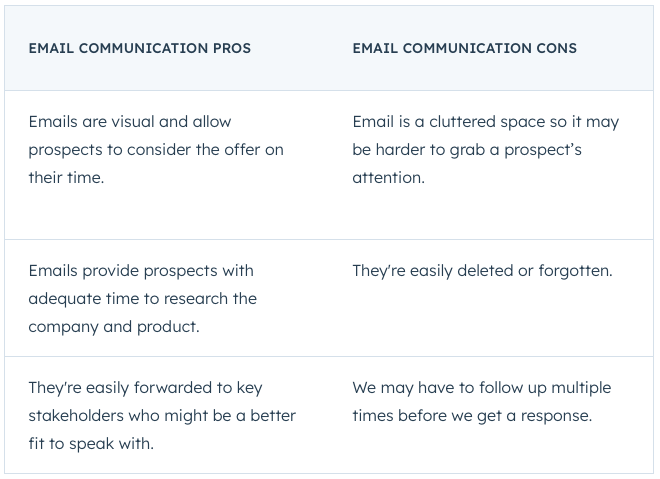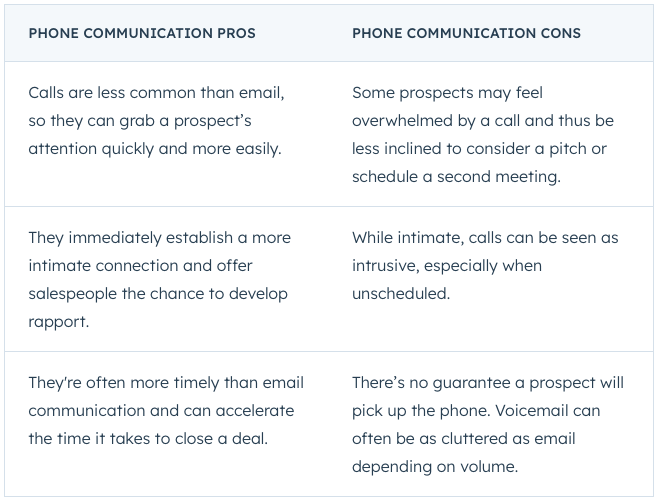Sales Prospecting Tips (Episode 2)
by Justin Arnold, Regional Director – North West England
6. Batch prospecting sessions
Batch prospecting sessions for 2 to 3 hours at a time and take a quick five-minute break between each hour. Get an egg timer and set the timer on a countdown for 20 minutes, 30 minutes, or 45 minutes, depending on how much time we scheduled for the call.
End the call on the timer’s beep, use 5 minutes for following up, 5 minutes for updating notes and administrative tasks in your CRM, and then use 5 minutes to prep for the next call.
7. Use a healthy mix of email and phone communication
In terms of establishing contact, we must decide between email or phone communication. Some of us initially jump on the cold email approach, while others dive into the cold call. This strategy will vary based on what each salesperson feels most comfortable with.
First, let’s look at the pros and cons of email communication:

Emails are visual and allow prospects to consider the offer on their own time. Email is cluttered, so it may be harder to grab a prospect’s attention.
Emails provide prospects with adequate time to research the company and product. They’re easily deleted or forgotten.
They’re easily forwarded to key stakeholders who might be better suited to speak with. We may have to follow up multiple times before we get a response.
Now, let’s look at the pros and cons of phone communication:

Calls are less common than email, so they can grab a prospect’s attention quickly and more efficiently. Some prospects may feel overwhelmed by a call and thus be less inclined to consider a pitch or schedule a second meeting.
They immediately establish a more intimate connection and offer salespeople the chance to develop rapport. While intimate, calls can be seen as intrusive, especially when unscheduled.
They’re often timelier than email communication and can accelerate the time it takes to close a deal. There’s no guarantee a prospect will pick up the phone. Voicemail can often be as cluttered as email, depending on volume.
Successful first-touch strategies often incorporate both approaches to take advantage of the pros and minimize the cons.
8. Use the BASHO sequence for emails and calls
Jeff Hoffman pioneered the BASHO sequence, which advocates a combination of voicemail and email messages to gain leverage with prospects.
- Voicemail / Email: Wait for 24 hours
- Voicemail / Email: Wait for 48 hours
- Voicemail / Email: Wait for 72 hours
- Voicemail / Email: Wait for 5 days
- Breakup Voicemail / Email
Alternating between voicemail and email, with unique messaging each time, this technique allows prospects to consider our offer, conduct their research, and respond at a convenient time.
But how do we leave a voicemail or send an email that prospects want to respond to? Let’s dive into the dos and don’ts of each communication method below.
The Warm Email
If we’re looking to send a first-touch email that gets opened, there are some essentials that we must include:
- Engaging subject line: The subject line must pique the prospect’s interest while avoiding cliché hooks.
- Personal opening line: We should begin our cold email by saying something about them, not us. After all, this process is about finding the prospect’s pain points and determining how to add value to their business or operations.
- Creating a connection: Now, we must make the connection. In our opening, they learn why we’re reaching out to them, but now they need to know why they should care about what we do.
- Clear call-to-action: Suggest a concrete time to connect or ask a close-ended question to clarify that the ball is in their court. Try using one of these lines: “Do you have ten minutes to catch up tomorrow?” or “Are you available for a 30-minute call on Tuesday between 9 and 11 AM?”
Try sending a calendar invite instead of an email to get straight to the point. In the description section, we can type up a personalized message like this:
Jill Konrath also suggests scheduling a short 5-minute meeting to get our foot in the door with prospects whose calendars are particularly swamped.
The Prospecting Call
If we decide to call a prospect, whether in conjunction with an email or not, we can follow this basic structure for the call:
- Establish rapport: We shouldn’t shy away from personal conversations, like asking how a prospect’s weekend was or what team they’re rooting for in the game tonight. These intimate touches help us develop a more meaningful relationship with prospects and enhance our likeability, which, hopefully, means a prospect will be more likely to buy from us.
- Leverage pain points: Dive into their pain points during the call. By the end of the conversation, we should know all of their primary business challenges and their underlying causes. Once we understand these key issues, we can better position our product or services to solve them.
- Create curiosity: Ask questions about their business. Ask more than telling. This conversation is about them and understanding their needs and problems. The less we talk about our business and product, the more our prospect will be interested to hear the final pitch.
- Wrap it up: Find a calendar time between 24-48 hours after the discovery call to book a follow-up meeting. Try this line: “Would you have 30 minutes to follow up this week? My colleague, John, will join us — he’s an X, Y, and Z expert. My calendar’s open; what works best for you?”
9. Follow-up after a closed-lost deal
Bryan Kreuzberger, the founder of Breakthrough Email, sends a follow-up email if prospects respond with a rejection. The purpose of this email is simple: Learning. We can use this rejection as an opportunity to understand better how we can improve our sales techniques by sending this template:
Hi [prospect name],
Thanks for your email. I just closed your file. I have a quick question as a final follow-up. Why aren’t you interested? Was it something I did?
If there is any way I can improve, let me know. I’m always looking for input.
Thanks for your help,
[Name]
10. Look at your prospects’ career pages
Reviewing job vacancies on a prospects website or people moves on LinkedIn, can provide further insight into the company’s current business activities. Looking to grow if recruiting salespeople, and operational staff maybe suggests increased production. As part of wider research, knowing your prospect is critical to
With all the steps and tricks involved in the prospecting process, we often spend too much time on menial tasks. We can use sales prospecting tools to boost productivity and automate tasks.
Look out for the last blog in the series on ‘Sales Prospecting Tools‘ and if you have any questions, please reach out to me at any of the below.
